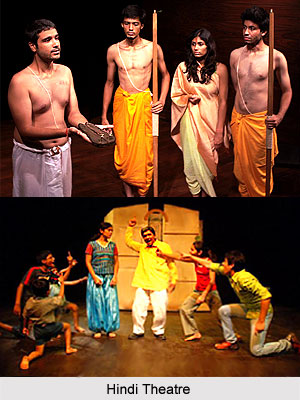 Hindi theatre has a tradition spanning more than four centuries. Hindi theatre can be said to be the continuity of Sanskrit theatre. It is eminent in different literary languages or spoken dialects of many states of northern India likeUttar Pradesh, Bihar, Jharkhand, Madhya Pradesh, Chhattisgarh, Rajasthan, Haryana, Himachal Pradesh, and Uttarakhand.
Hindi theatre has a tradition spanning more than four centuries. Hindi theatre can be said to be the continuity of Sanskrit theatre. It is eminent in different literary languages or spoken dialects of many states of northern India likeUttar Pradesh, Bihar, Jharkhand, Madhya Pradesh, Chhattisgarh, Rajasthan, Haryana, Himachal Pradesh, and Uttarakhand.
History of Hindi Theatre
The advent of Mughal Dynasty led to the fall of the Sanskrit language. However, traditional folk theatre consisting of Ramlila, Raslila and nautanki had evolved. With time many eminent pioneers also contributed to the development of Hindi Theatre. One of the important pioneers in the late 19th century had been Bharatendu Harishchandra (1850-85). He established an amateur group with his literary associates, writing, staging, and acting in his own and other plays. He even at times travelled to nearby towns in Uttar Pradesh and Bihar with his productions. Janaki mangal (`Janaki`s Marriage`, 1867) is the first such drama composed by one of the associates of Harishchandra, Sitala Prasad Tripathi, and produced in Varanasi. Jaishankar Prasad was another recognized Indian dramatist credited with writing about a dozen plays that took the Hindi theatre to a new level.
In the 1940s, two major developments gave a boost to Hindi theatre. The launching of the Indian People`s Theatre Association (IPTA) in 1943 by the Communist Party of India and the Prithvi Theatre, a professional travelling company started by the renowned film star Prithviraj Kapoor.
Later Developments of Hindi Theatre
After Independence there was an upsurge of creative energy in India that also gave Hindi drama a boost. Many important plays were written during this period like the Jagdish Chandra Mathur`s Konarka (1950), Dr. Dharamvir Bharati`s `Andhayug`, Mohan Rakesh`s `Ashadh ka ek din.`
Various implementations of official policies also gave a boost to this creative enthusiasm. The Government of India established autonomous bodies in New Delhi. Sangeet Natak Akademi (SNA) set up in 1953 and the National School of Drama (NSD) in Delhi.
Gradually many new groups began to form in different cities, some of them were, Darpana in Kanpur, Allahabad Artists Association in Allahabad, Rupantar in Gorakhpur, Kala Sangam in Patna. Dishantar, another notable company was formed in Delhi in 1967 by NSD alumni. Over a period of ten years the group gave excellent productions. The Tagore centenary celebrations observed nation wide also led to the establishment of many playhouses named after Rabindranath Tagore. In Delhi, the multipurpose Mavalankar Hall with 800 seats was built. The open-air Triveni Kala Sangam was another hall that was erected.
Elements of Hindi Theatre
Hindi theatre found its expression in varied theatrical narratives like Ramlila, Raslila, Bhagat, Nautanki/Sangit/Swang, and Naqal, Bidesiya, Mach, Nacha and Pandavani. The natyas are an important part of the Hindi Theatre.
The natyas (theatres) in Hindi Theatres included many elements from Sanskrit dramaturgy like incorporation of rasa, sources for themes and stories from Mahabharata, Ramayana, and Bhagavata Purana. These also include theatrical approaches, conventions, and practices like the purvaranga (preliminaries), kakshya vibhaga (stage zones or locales), and treatment of time and space. Different roles like that of the sutradhara (director-manager) and vidushaka (jester) are also important. The plays of Hindi Theatre employed memorized or written synopses taken from mythological or historical episodes, legends, and tales. These are written by the performers with the help of poetry, song, dance, and mime. Later in the eighteenth and nineteenth centuries, many others like the Nautanki, Swang, Bidesiya, Mach, Nacha, Xaqal, Karyala came into being. These were based on secular themes. Even the devotional theatres which were dominated by ritualistic, spiritual content and tone had the feel of contemporary social reality. These theatres infused music and dance with words as a mode of communication that enriched the performances aesthetically. Solo performance is another element of Hindi Theatre that emerged on account of shortage of funds. It was evolved because actors did not have the time to work with a team.
Hindi Theatre Personalities
The History of Indian Theatre dates back to more than 5000 years and the Hindi theatre personalities are closely associated with all the achievements. There are many important personalities who have greatly contributed to the development of Hindi Theatre. Some of them are Ram Swarup Sharma, Khanchand Shamdas Daryani, Kanaiyalal Maneklal Munshi, Amarendra Nath Dutta, Hari Krishna Premi, Maharaj Krishna Raina, Rajinder Nath, Surekha Sikri, Quasar Thakore Padamsee, Dolly Thakore, Ramesh Mehta and others. Many notable directors from non Hindi regions also contributed to the Hindi Theatre like Alkazi from Mumbai, Bansi Kaul (1934- ) from Srinagar, Usha Ganguli (1945- ) from Kolkata, Amal Allana (1947- ) from Mumbai, M.K. Raina (1948) from Srinagar, Feisal. Many distinguished women playwrights also contributed towards Hindi Theatre like the Mridula Garg, Mrinal Pande, and Kusum Kumar, and scripter-directors Tripurari Sharma, Kirti Jain, Anuradha Kapur, Anamika Haksar, and Nadira Zaheer Babbar.




















